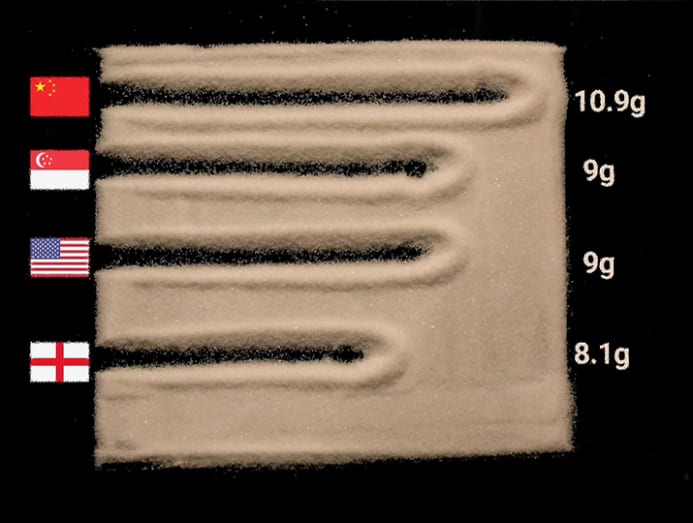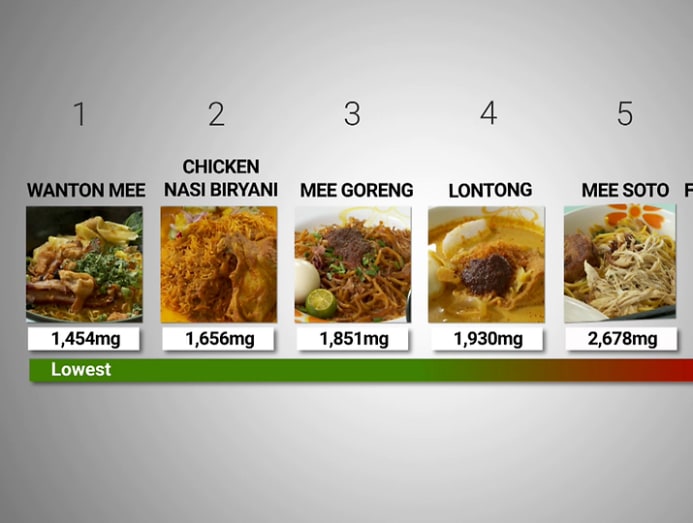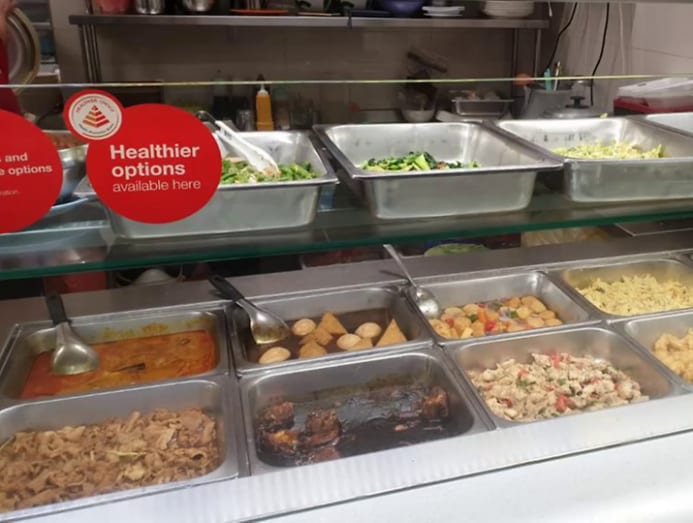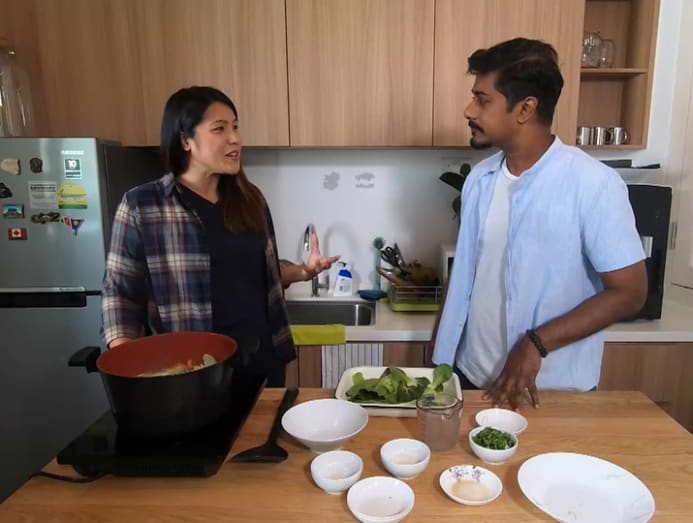Want to cut back on salt and still have tasty meals? Here are 7 tips
Advertisement
CNA Insider
Desire to cut back on table salt and still have tasty meals? Hither are 7 tips
Too much salt can exist a wellness adventure, but that has not deterred Singaporeans. The programme Talking Signal finds out what's behind the nation'due south high daily intake, and some surprising facts about the popular flavouring.

Six dishes, just which has the most salt? You may be surprised at the reply.
20 Mar 2022 12:30PM (Updated: 27 Mar 2022 11:44AM)
SINGAPORE: Craven biryani and fried fish soup with milk are amidst Singaporeans' favourite hawker dishes. Merely judge which 1 has more salt.
Information technology turns out that fish soup will bust your daily salt limit.
Already, the average Singaporean consumes 9g of salt daily, according to the National Diet Survey 2018. This is almost double the 5g intake (slightly less than a teaspoon) recommended by the Globe Wellness Organisation and the Health Promotion Lath (HPB).
Singapore's salt consumption also ranks upward there with countries like Prc, England and the Us.
Salt adds flavour to food, but too much of it in ane's nutrition can lead to health problems such as hypertension — and an increased run a risk of stroke and kidney failure.
Is it possible, still, to have delicious depression-table salt meals?

Talking Point host Rai Kannu, who has a family unit history of hypertension, tried to stick to less than a teaspoon of salt a solar day for two weeks, to see if Singaporeans would be able to reduce their daily salt intake.
Hither are seven things he learnt about salt forth the way:
1. IT IS NOT NECESSARILY A VILLAIN
Salt, which is fabricated upward of sodium and chlorine, is the main dietary source of sodium, so the terms "salt" and "sodium" are frequently used interchangeably.
In 5g of common salt, the recommended daily intake, in that location would exist ii,000mg of sodium. And it is an essential part of one'due south nutrition. Sodium helps to transmit nerve impulses, keeps muscles working properly and maintains the trunk's fluids in residual.
WATCH: How to go on a depression-common salt diet in Singapore? Rai tries for two weeks (six:30)
Only likewise much sodium tin lead to water retention in the body, which then increases claret volume and leads to high claret pressure (hypertension). This will, in turn, increase the take a chance of stroke, eye disease and kidney failure.
2. It IS HIDING IN THE SAUCES
About of Singaporeans' dietary sodium comes from sauces, seasoning and condiments, according to William Chen, the director of Nanyang Technological University's Food Science and Engineering Programme.
A tablespoon of oyster sauce has about 500mg of sodium, while the aforementioned corporeality of soya sauce has nearly 1,000mg of sodium. And there is about 1,500mg of sodium per tablespoon of fish sauce.
"When nosotros melt a dish, unremarkably we don't really measure how much we add in, and so all these together contribute to the high level of sodium in the dishes," said the professor.

This is why "fish soup may seem to be less oily" than dishes like mee goreng and lontong, "but information technology actually contains a lot of sodium".
3. EATING OUT DRIVES UP THE Table salt INTAKE
Since most 2011, the HPB has tried to educate Singaporeans about reducing their table salt intake. But the "growing tendency of eating out" has led to higher overall common salt consumption, said HPB senior managing director (policy and strategy development) Melissa Koh.
The HPB has the Healthier Dining Programme to partner the food and beverage industry to provide lower-calorie meals with the Healthier Choice Symbol. But the statutory board might at present go a step further.
"We're now studying the demand and the feasibility of extending this to lower-sodium labels," said Koh, who has been studying how to get food operators to reduce the sodium level in their dishes.

iv. LOW-SODIUM SUBSTITUTES ARE Available
The HPB has likewise conducted trials with two "major" caterers. "Both, during the report period, switched over to reduced sodium salt, sauces and seasonings," cited Koh, a nutritionist. "Sodium reduction was meaning — about 30 to 38 per cent beyond sites."
She said most of the consumers in the trials could not tell the difference.
"(Among) those who actually could taste the difference, some liked the lower-sodium taste, which means in that location's still that margin where food service operators can reduce their sodium without compromising taste," she added.
When Rai did a similar taste test, he did not notice any divergence either.

Low-sodium salt has function of the sodium chloride removed and replaced with potassium chloride or other mineral salts, leaving it with typically 40 per cent less sodium than regular salt, Koh explained.
It is prophylactic for "a bulk of the population", though she noted: "Those with impaired kidney function will demand to be a bit more careful considering it does increment the run a risk of hyperkalaemia (likewise much potassium in the blood)."
v. AVOID PROCESSED FOODS AT HOME
Cooking at dwelling house helps to control ane's dietary sodium, and consumers can ensure this past sticking to non-processed foods and avoiding deep-fried stuff, recommends sports and diet double-decker Aqilah Norazman, the founder of Asian Repast Prep.
"Even when you're choosing veggies, try as much as possible to become raw and minimise the ones that are cooked with a lot of stock … and a lot of gravy," she said.

She too recommends herbs, spices and natural flavor enhancers, like onions or bound onions, instead of salt.
"Even the healthiest food has a little flake of sodium in information technology, and so you don't need to add together in whatever extra salt," she said.
6. IS One TEASPOON Really THE LIMIT?
There are "definitely benefits" of keeping to the recommended level, said Singapore Eye Foundation senior nutritionist Lim Kiat. Reducing the global salt intake to less than 5g per mean solar day could prevent 2.v million deaths annually, he cited.
In Singapore, nearly one in four residents aged thirty to 69 — and more than one-half of those aged 60 to 69 — take hypertension, he noted.

"Hypertension is a silent killer, which means it doesn't cause any symptoms even when the condition is severe," he added.
"Hypertension is one of the key risk factors for cardiovascular illness. It impacts around ane out of 3 deaths in Singapore."
seven. TWO WEEKS Tin Make A DIFFERENCE
Dr Tan and Partners' primary medical officeholder, Julian Ng, who tracked Rai's health markers before and afterward the latter'southward two-week regimen, said a depression-salt diet helps mainly to prevent blood pressure problems from developing rather than improving the claret pressure.
For example, Rai's blood force per unit area, which was normal all along, was unchanged. But his level of aldosterone, a hormone that helps to regulate claret pressure level, most doubled because of his reduced common salt intake.
WATCH: A ii-calendar week low-sodium nutrition: Can I live on 1 teaspoon of salt per day? (22:12)
With the increase, his body keeps his claret pressure and heart rate under control. "You obviously don't want wild fluctuations," said Ng.
A long-term high-salt nutrition, however, would "signal to the torso" to set a "new normal".
"And over time, due to increasing age and all the various factors, the trunk would endeavor to reset the blood pressure point," he added. "It actually starts to increase."
Watch this episode of Talking Point here. The programme airs on Channel 5 every Thursday at ix.30pm.
Recent Searches
Trending Topics
Source: https://cnalifestyle.channelnewsasia.com/cna-insider/want-cut-back-salt-and-still-have-tasty-meals-here-are-7-tips-284551

Post a Comment for "Want to cut back on salt and still have tasty meals? Here are 7 tips"